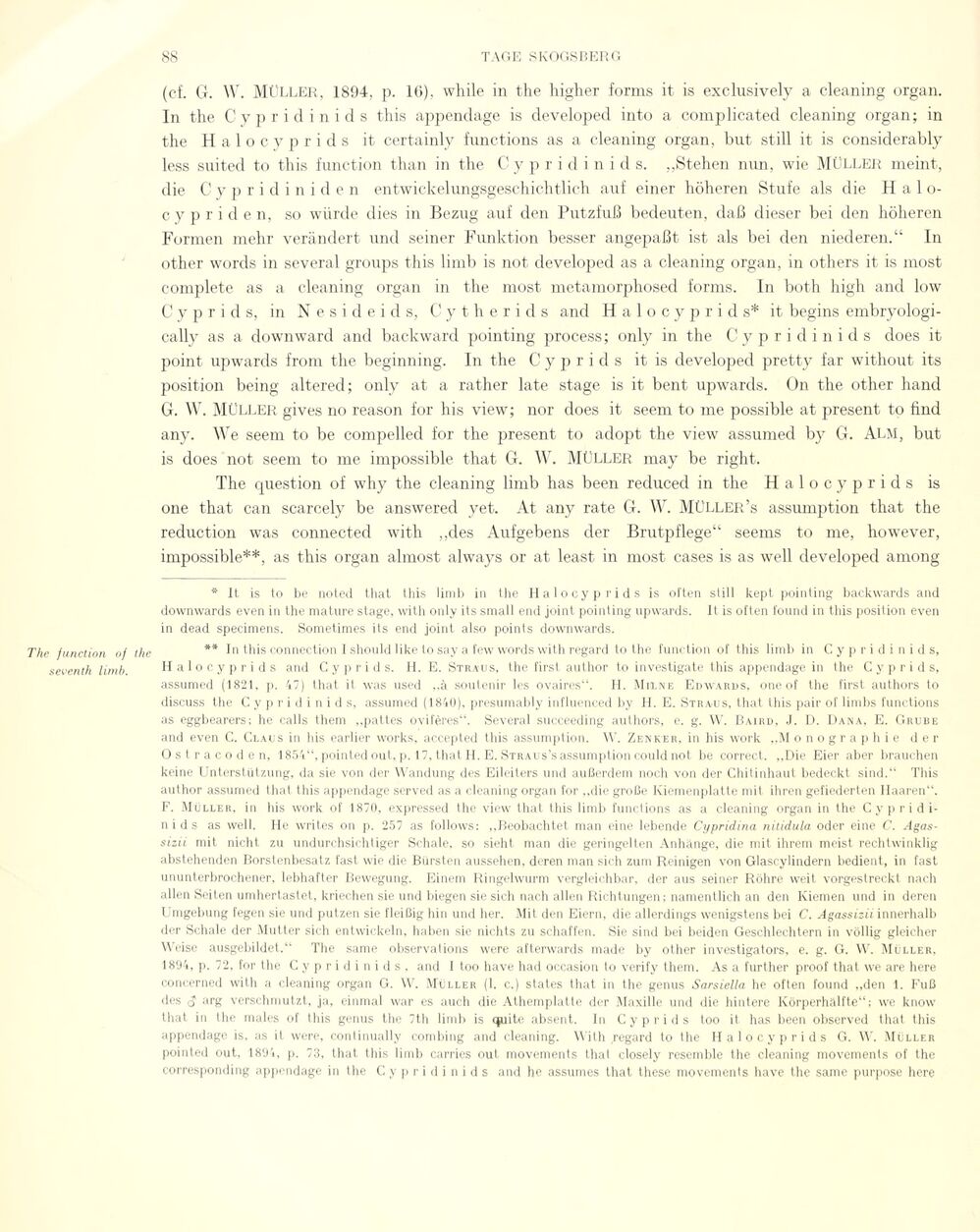
Full resolution (JPEG) - On this page / på denna sida - Sidor ...

<< prev. page << föreg. sida << >> nästa sida >> next page >>
Below is the raw OCR text
from the above scanned image.
Do you see an error? Proofread the page now!
Här nedan syns maskintolkade texten från faksimilbilden ovan.
Ser du något fel? Korrekturläs sidan nu!
This page has never been proofread. / Denna sida har aldrig korrekturlästs.
The function oj
seventh lirnb.
(cf. G. W. Müller. 1894, p. H>), while in the higher forms it is exclusively a eleaning organ.
In the Cypridi nids this appendage is developed into a complicated eleaning organ; in
the Halocyprids it certainly fonctions as a eleaning organ, but still it is considerably
less suited to this function than in the Cypridinids. „Stehen nun, wie Müller meint,
die Cypridiniden entwickelungsgeschichtlich auf einer höheren Stufe als die
Halo-cypriden, so würde dies in Bezug auf den Putzfuß bedeuten, daß dieser bei den höheren
Formen mehr verändert und seiner Funktion besser angepaßt ist als bei den niederen.“ In
other words in several groups this limb is not developed as a eleaning organ, in others it is most
complete as a eleaning organ in the most metamorphosed forms. In both high and low
C y p r i d s, in N e s i d e ids, Cytherids and Halocyprids* it begins
embryologi-cally as a downward and backward pointing process ; only in the Cypridinids does it
point upwards from the beginning. In the C y p r i d s it is developed pretty far without its
position being altered; only at a rather late stage is it bent upwards. On the other hånd
G. W. Müller gives no reason for his view; nor does it seem to me possible at present to find
any. We seem to be compelled for the present to adopt the view assumed by G. Alm, but
is does not seem to me impossible that G. W. MÜLLER may be right.
The question of why the eleaning limb has been reduced in the Halocyprids is
one that can scarcely be answered yet. At any rate G. W. MüLLER’s assumption that the
réduction was connected with „des Aufgebens der Brutpflege“ seems to me, however,
impossible**, as this organ almost always or at least in most cases is as well developed among
* It is to be noted that this limb in the Halocyprids is often still kept pointing backwards and
downwards even in the mature stage, with only its small end joint pointing upwards. It is often found in this position even
in dead specimens. Sometimes its end joint also points downwards.
i)ie ** In this connection I should like to say a few words with regard to the function of this limb in Cypridinids,
Halocyprids and C y p r i d s. H. E. Straus, the first aut.hor to investigate this appendage in the C y p r i d s,
assumed (1821, p. 47) that it was used ,.à soutenir les ovaires“. H. Milne Edwards, one of the first authors to
discuss the Cypridinids, assumed (1840), presumably influenced by H. E. Straus, that this pair of limbs funetions
as eggbearers; he calls them „pattes ovifères“. Several succeeding authors, e. g. W. Baird, J. D. Dana, E. Grube
and even C. Claus in his earlier works, accepted this assumption. W. Zenker, in his work „M onographie der
Ostracoden, 1854“, pointed out, p. 17, that H. E. Straus’s assumption could not be correct. „Die Eier aber brauchen
keine Unterstützung, da sie von der Wandung des Eileiters und außerdem noch von der Chitinhaut bedeckt sind.“ This
author assumed that this appendage served as a eleaning organ for „die große Kiemenplatte mit ihren gefiederten Haaren“.
F. Müller, in his work of 1870, expressed the view that this limb functions as a eleaning organ in the
Cypridinids as well. He writes on p. 257 as follows: „Beobachtet man eine lebende Cypridina nitidula oder eine C.
Agas-sizii mit nicht zu undurchsichtiger Schale, so sieht man die geringelten Anhänge, die mit ihrem meist rechtwinklig
abstehenden Borstenbesatz fast wie die Bürsten aussehen, deren man sich zum Reinigen von Glascylindern bedient, in fast
ununterbrochener, lebhafter Bewegung. Einem Ringelwurm vergleichbar, der aus seiner Röhre weit vorgestreckt nach
allen Seiten umhertastet, kriechen sie und biegen sie sich nach allen Richtungen; namentlich an den Kiemen und in deren
Umgebung fegen sie und putzen sie fleißig hin und her. Mit den Eiern, die allerdings wenigstens bei C. Agassizii innerhalb
der Schale der Mutter sich entwickeln, haben sie nichts zu schaffen. Sie sind bei beiden Geschlechtern in völlig gleicher
Weise ausgebildet.“ The same observations were afterwards made by other investigators, e. g. G. W. Müller,
1894, p. 72, for the C y p r i d i n i d s , and I too have had occasion to verify them. As a further proof that we are here
concerned with a eleaning organ G. W. Müller (1. c.) states that in the genus Sarsiella he often found „den 1. Fuß
des <$ arg verschmutzt, ja, einmal war es auch die Athemplatte der Maxille und die hintere Körperhälfte“; we know
that in the males of this genus the 7th limb is quite absent, ln Cyprids too it has been observed that this
appendage is, as it were, continually combing and eleaning. With regard to the Halocyprids G. W. Müller
pointed out, 1894, p. 73, that this limb carries out movements that closely resemble the eleaning movements of the
corresponding appendage in the Cypridinids and he assumes that these movements have the same purpose here
<< prev. page << föreg. sida << >> nästa sida >> next page >>